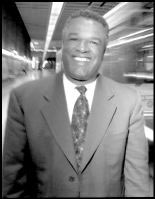Over six months after Mayor Greg Nickels took office, he continues to bewilder City Hall. This puzzlement seems a bit odd, since Nickels has been sending consistent messages: (1) I’m in charge. (2) I want measurable results.
Last week’s furor over racial profiling is the latest case in point. For 18 months, the Seattle City Council, led by Police Committee chair Jim Compton, worked up a set of proposals to deal with accusations of racial profiling by police. Compton engaged in a classic Seattle process: He brought different interests to the table in the Racial Profiling Task Force, worked proposals over and over, and came up with a plan for collecting data over the next year on how many members of what race get stopped in which neighborhoods. The information gleaned would be entered into a searchable database. Once the data was collected, there probably would have been another lengthy round of debates over what it all meant. Compton’s articulated goal was to use the data to see if police training should be changed in some fashion.
Nickels didn’t like the plan. Since the City Council had merely passed a resolution directing the mayor to carry the plan out, rather than a law requiring him to do so, he said he wouldn’t implement it. Instead he would take a couple of weeks and develop his own plan.
A common and convincing speculation about Nickels’ motivation heard among the City Council members and staff went like this: In April the Seattle Police Guild intimidated Chief Gil Kerlikowske with an overwhelming vote of no confidence; the guild made no secret of its objections to the City Council’s plan on racial profiling; the guild must have pressured the chief, who, in turn, leaned on the mayor, who spiked the council’s plan. Nickels would no doubt produce a milquetoast plan to appease the guild.
Last week, Nickels instead surprised City Hall by coming out with a complicated plan on racial profiling that didn’t please anyone entirely—City Council members, the police guild, or the citizens involved in the Racial Profiling Task Force (see “Half a Plan?” p. 15). As is the mayor’s habit, he freely took ideas from other people and claimed them as his own.
What were the salient characteristics of the plan? It “doesn’t just gather data like the City Council,” Nickels claims. Instead, Nickels wanted clear, measurable results: (1) install digital video cameras in all police cars (never mind how we’re going to pay for it); ( 2) document all traffic stops, including those that do not result in a citation; (3) review and update officer training on racially biased policing; and (4) poll the citizens every other year to measure attitudes about interactions with police and more. Both his own approach and his critique of the City Council’s harkened back to Nickels’ themes on the campaign trail: Don’t do process just for the sake of process; instead, gather input, decide what to do, set clear goals, and get to work producing them.
The other obvious thing about the mayor’s plan was, well, it was the mayor’s. It was developed by his staff and would be implemented by his police chief. After meeting with Nickels, Seattle Human Rights Commissioner Pat Champion, who served on the City Council’s Task Force, said bitterly, “If it wasn’t on his watch, [the mayor] is going to start fresh and do it his way. I thought it was about getting the work done, not taking ownership.”
Why is Champion, or anyone else for that matter, surprised by this? One can certainly sympathize with Champion and others who feel their months of work are now being ignored, but Nickels has not deviated from this my-way-or-the-highway path one iota since taking office.
“It’s very different for Seattle politics,” says longtime political observer David Brewster of Town Hall. Brewster argues Seattle hasn’t seen a political machine as tough, disciplined, and single-minded as Nickels’ since the 1940s. “It’s a strange cultural adjustment going on.”
The other obvious reason for the slow uptake on Nickels’ modus operandi is the cognitive dissonance between his personality and his political style. It’s hard to comprehend that this smiling big teddy bear of a guy is showing you the door, thanking you for your input, and proceeding to do exactly what he wants—regardless of what you think about it.
Get used to it, Seattle. Nickels ain’t showing any signs of changing.









